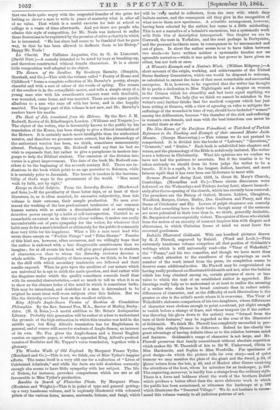Dalziel's Illustrated Goldsmith. With one hundred pictures drawn by G.
J. Pinwell, engraved by Dalziel. (Ward and Lock.)—This extremely handsome volume comprises all that portion of Goldmith's writings which is still universally read—the "Vicar of Wakefield," the "Poems," and his two comedies, and though we have more than once called attention to the excellence of the engravings as each number of the work issued from the press, its completion seems to deserve some additional notice. Mr. Pinwell may be congratulated on having really produced an illustrated Goldsmith and not, after the fashion which has long obtained among us, certain pictures of more or less value to which the text of an established author is appended. His• drawings really help us to understand or at least to realize the meaning- of a writer who deals less in broad contrasts than in rather subtle differences of character, and as the difficulty of such illustrations is the greater so also is the artist's merit where it is overcome. The Vicar of Wakefield's elaborate comparison of his two daughters, whose differences. of character were obvious enough to point a contrast, yet slight enough to vanish before a change of dress, and whose tempers (as if the author was throwing his glove down to the artists) were "formed from the turn of their features," may be regarded as the crux of the illustrator of Goldsmith. We think Mr. Pinwell has completely succeeded in pre- serving this sisterly likeness in difference. Indeed he has clearly the great advantage of having definite ideas as to the relation between mind and features. Goldsmith's range of character is not large, and Mr. Pinwell preserves that family resemblanair without absolute repetition which makes Sir W. Thornhill of kin to Sir W. Underwood, Olivia to Miss Hardcastle, and Sophia to Miss Woodville. FQr specimens of good design—in which the picture tells its own story—and of quiet humour we may mention the plate of the giant and the dwarf, p.53, of /doses' return from the fair, p. 49, and of Marlow after dinner receiving the attentions of the host, whom he mistakes for an innkeeper, p. 358. The engraving, moreover, is hardly less a change from the ordinary style. There is a force and boldness about the work of the brothers Dalziel which produce a better effect than the more elaborate work to which the public has been accustomed, as witnesses the landscape at p. 193 which illustrates the "Deserted Village." We do not hesitate to recom- mend this volume warmly to all judicious patrons of art.






























 Previous page
Previous page